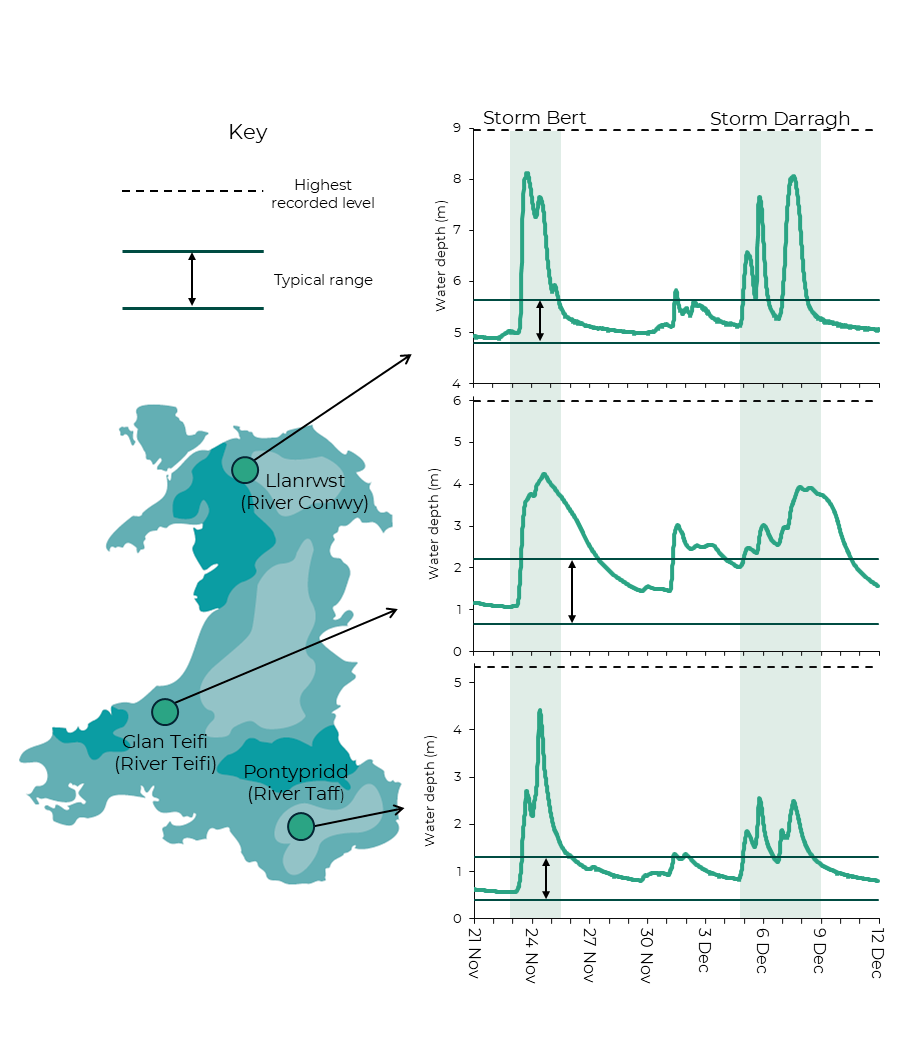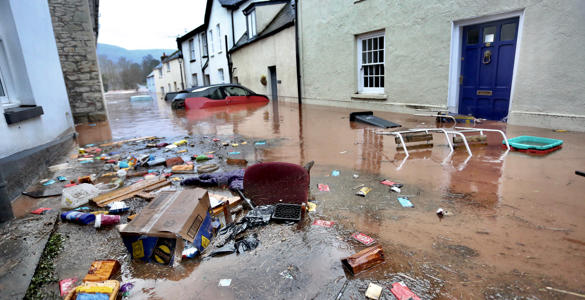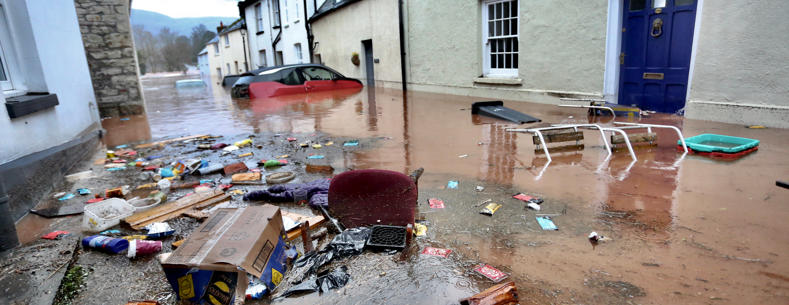In the space of two weeks in late 2024, Storm Bert and Storm Darragh hit Wales. Communities from Pontypridd to Holyhead were hit by flooding, landslides, and severe wind. This article explores storm forecasting, impacts, and responses, alongside Wales’s current and future climate.
Storms and flooding in Wales
Northwest Europe, including Wales, has a mild and rainy oceanic climate. Warm ocean currents and westerly winds combine to deliver moisture-rich weather systems onto land, where they may create storms. In the British Isles, storms occur more frequently during the winter.
Five years ago, Storms Ciara and Dennis brought major flooding and severe winds to Wales. Impacts included extensive flooding in Pontypridd and the partial collapse of a disused coal tip near Tylorstown, Rhondda Cynon Taf (RCT). The Welsh Government responded by introducing legislation addressing disused mine and quarry tips, and it continues to fund Flood Risk Management Authorities in Wales.
Natural Resources Wales (NRW) is the responsible Flood Risk Management Authority for main river flooding. It issues flood warnings and alerts when forecasts suggest flooding is likely. NRW published flood risk management plans for every region of Wales in 2023.
The Met Office is a UK Government-owned body that provides the Public Weather Service and the National Severe Weather Warning Service. It issues yellow, amber, and red warnings when disruptive weather is forecasted.
Storm Bert
From Friday 22 to Monday 25 November 2024, Storm Bert brought serious damage to Wales. In the south Wales valleys, total rainfall during Storm Bert was between 50% and 100% of the average expected during the whole month of November. Some rivers, such as the Ebbw at Aberbeeg, reached their highest level ever recorded. More than 700 properties were flooded across Wales.
The graphic below illustrates how water levels changed in three rivers between 21 November and 12 December 2024. This span includes Storm Bert and Storm Darragh, which are highlighted by vertical bars.

The River Taff flooded extensively and Pontypridd, which had been badly hit by Storm Dennis in 2020, was again one of the most severely affected towns. RCT Council, which declared an emergency incident, said over 2000 properties had been protected by flood alleviation schemes and that it has spent more than £100m on improvements to flood defences since Storm Dennis.
At Cwmtillery, Blaenau Gwent, a disused coal tip partially collapsed, forcing the evacuation of around 40 homes as rock and mud flowed onto residential streets. The tip had been assessed as ‘Category D’ (highest risk) by the Mining Remediation Authority (formerly the Coal Authority) during inspections that have taken place since the Tylorstown landslide in 2020.
A large sinkhole opened on a residential street in Merthyr Tydfil after a Victorian-era underground culvert was damaged by boulders.
In north Wales, one person died in floodwaters in Trefriw, Conwy.
Flooding and infrastructure damage led to widespread disruption of railways, including the closure of the Heart of Wales and Marches lines. Numerous roads were also closed due to flooding and landslides, including the A479 in Powys and the A4042 in Monmouthshire.
The Met Office issued a yellow warning for rain covering most of Wales ahead of Storm Bert. This is the lowest of the three tiers of weather warnings, and can either mean “some low level impacts” are likely, or “much more severe impacts” could occur, but with low certainty.
NRW issued 131 alerts and flood warnings on the Saturday morning, including two severe flood warnings on the River Monnow in Monmouthshire.
During First Minister’s Questions on 26 November 2024, the then-Leader of the Opposition, Andrew R.T. Davies MS, expressed concern that a higher tier of weather warning was not issued, saying:
Many people indicated in some of the most severely affected areas in Pontypridd that the first that they realised the flooding was taking place was when neighbours were going from house to house banging on the doors.
Plaid Cymru leader, Rhun ap Iorwerth MS, said the Welsh Government “doesn’t seem to have learnt the lessons” from flooding in 2020.
In the same session, the First Minister, Eluned Morgan MS, said “I accept that people need better warning, and that is something, clearly, that will need to be discussed with NRW and the Met Office”.
In December 2024, an NRW spokesperson told the House of Commons’ Welsh Affairs Committee:
In Storm Bert, it is true to say that there was a rapid escalation on that Saturday morning, which was because the weather systems hit some of the steep-sided rapid-responding catchments and valleys, such as the Taff catchment. It makes forecasting extremely difficult in those sorts of circumstances.
After the storm, the Welsh Government funded grants of £500 and £1000 to households impacted by flooding. Some Local Authorities also offered financial support – RCT Council provided £1000 grants for affected residents and businesses.
Storm Darragh
Storm Darragh arrived two weeks after Storm Bert and was characterised by extremely high winds. The Met Office issued a rare red ‘take action’ warning for wind covering west Wales and the Bristol Channel coastline. The UK Government also issued an emergency alert by phone to those in affected areas, marking the first deployment of this system in Wales since its introduction in 2023.
There was substantial damage to the low-voltage electricity distribution network across Wales, which delivers power directly to properties. These networks are maintained by the private companies National Grid Electricity Distribution (NGED) in the south, and SP Energy Networks (SPEN) in the north.
Approximately 95,000 homes were without power on 7 December. An NGED spokesperson said power had been restored to all customers by 14 December. SPEN said fewer than 500 customers remained without power by 12 December..
The 150-year-old Llandudno pier suffered damage as several kiosks were ripped from their foundations. The pier’s general manager said it may cost “about £250,000” to repair the damage.
Damage to berthing infrastructure during Storm Darragh forced the Port of Holyhead to close entirely for over a month. Ken Skates MS, Cabinet Secretary for Transport and North Wales, recently told the Senedd he would “establish a Welsh Government led multi-stakeholder task force to develop a new strategy for the future of Holyhead”, with a focus on “climate-driven changes in severe weather patterns”.
Adapting to future storms
Storms have always occurred in the British Isles, but in recent decades the intensity of winter rainfall has increased due to climate change. Last winter (2023-24) was the UK’s second wettest since records began. Further increases to average winter rainfall and storm frequency are likely to occur this century, putting 23% more Welsh properties at risk of flooding by rivers by 2120.
The need for sustainable and resilient future flood management solutions was emphasised by the National Infrastructure Commission for Wales (NICW) in its October 2024 flooding report. NICW also recommend greater use of nature-based methods and increased community involvement in future approaches.
Article by Matthew Sutton, Senedd Research, Welsh Parliament






